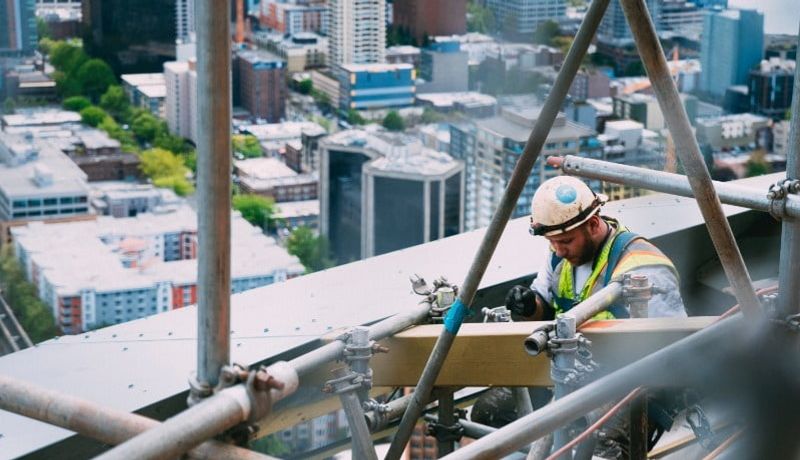A good engineer must possess many talents. Creative problem-solving skills and strong mathematical ability are must-haves. A keen eye for detail is essential. A knack for mechanical reasoning also helps.
Add sustainable building knowledge to that list.
Of course, engineers have been grappling with the challenges of sustainability for many years. But it has long ceased to be a niche skillset and become a vital asset for any engineer looking to build a healthy, long career in the industry. Commercial and residential buildings accounted for 39 per cent of U.S. carbon emissions in 2017, according to the U.S. Energy Information Administration. Any plan to cut reduce emissions needs to tackle the built environment, and engineers will be central to those efforts.
For an engineer working in the mechanical, electrical, and plumbing (MEP) sectors, sustainability can take many different forms. Mechanical engineers will need to understand how to maximize the efficiency of building systems. Electrical engineers may find themselves having to rethink the layout of lighting systems in order to save on energy. Plumbing engineers will find clients interested in rainwater capture systems and other ways to cut down on fresh water use.
To keep abreast of changing sustainability technologies and standards, MEP engineers will need to consider accreditation in green building standards, including, most notably, LEED (Leadership in Energy and Environmental Design), which has become one of the most common sustainability certifications found across the globe.
In its most recent annual report, the World Green Building Council (WGBC) notes that 1.24 billion square metres of floor space have been certified worldwide under the LEED program. That growth suggests there is value in engineers earning the designation of LEED Accredited Professional. By taking a test through their regional Green Building Council, professionals can have their green credentials officially recognized.
A LEED AP specialty like Building Design & Construction, while not yet at the level of professional must-have, is particularly relevant to MEP engineers working in the building services sector, comments Alex Hayes, Director, LVI Associates.
“At the moment, clients say it is a preferred accreditation, but I imagine this could change in the future,” he says.
Indeed, the building industry is likely to put increasing importance on sustainability in the coming years as efforts to reduce carbon emissions gain momentum. One sign of the changing market: the WGBC is globally launching the Net Zero Carbon Buildings Commitment this year. The initiative’s goal is to have new buildings operating at net-zero carbon emissions by 2030 and all buildings at net zero by 2050.
If the industry intends to reach that 2050 target, it will require a considerable amount of engineering talent and ingenuity. Cities are filled with decades’ worth of structures built before sustainability guidelines took root. To reduce carbon emissions, older buildings will need considerable retrofitting. Aging, inefficient mechanical systems will need to be entirely replaced; in some cases, building envelopes will need to be completely redeveloped.
Hayes notes that restoration is one of the fastest growing engineering subsectors. Many of the skills involved on new builds transfer readily to retrofit projects, but engineers experienced in working on existing buildings may be able to carve out a valuable niche for themselves.
“People who have experience with historic buildings and old structures are seeing increasing demand for their services, particularly in the larger cities of the Northeast United States,” Hayes says.
States like California and many of the larger urban centres have placed a strong emphasis on sustainability, but the challenges of greening the built environment are being addressed throughout many different parts of the U.S. In their 2017 National Green Building Adoption Index, CBRE and Maastricht University say that Chicago is the top market in the country for green buildings, with 66 per cent of the city’s built space certified green. San Francisco, Atlanta, Houston, and Minneapolis/St. Paul round out the top-five markets.
For sustainable building engineers, the opportunities stretch across the country. But more than just a career stepping stone, these sustainability projects offer a rewarding professional challenge for any engineer looking to prove his or her talents.
“Sustainable buildings are always the more complex, more interesting and more expensive projects,” Hayes says.
------------
About Us
LVI Associates is the leading specialist recruitment agency for the infrastructure sector. We were born from the fusion of two existing companies—Laking Group and Viridium Associates who recruited for the oil and gas and renewable energy markets. While working for some of the largest energy companies in the world, we realised that we could transform more careers and support greater projects and companies by opening our services to the wider infrastructure market. More than the sum of our parts, today LVI Associates provides permanent, contract and multi-hire recruitment from our global hubs in Boston, London and Singapore. Contact us to find out more.
